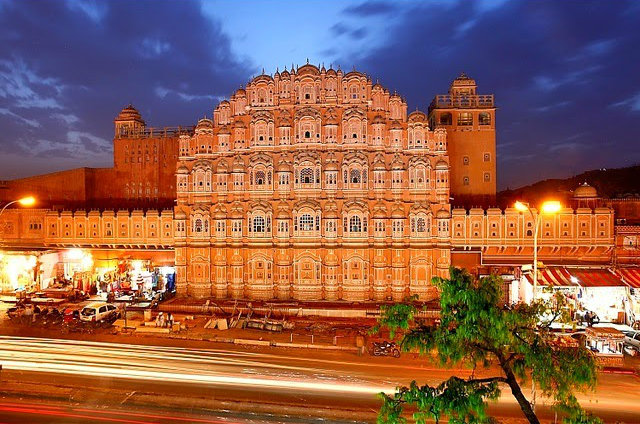Hawa Mahal Jaipur: The Iconic Palace of Winds and Pink City Charm
Hawa Mahal Jaipur: The Iconic Palace of Winds and Pink City Charm
Blog Article
The Historical Origins of Hawa Mahal
Constructed in 1799 by Maharaja Sawai Pratap Singh, the Hawa Mahal, or “Palace of Winds,” stands as a testament to the architectural innovation of the Rajput era. Inspired by the structure of Khetri Mahal in Jhunjhunu, the palace was built by Lal Chand Ustad. Its primary function was to allow royal women to observe street festivals and daily life from behind the lattice windows, all while preserving the purdah system. Over the centuries, it has become one of the most defining landmarks of Jaipur, Rajasthan's capital city, often referred to as the Pink City for its uniformly colored architecture.
Unique Architectural Design and Symbolism
Hawa Mahal’s most iconic feature is its five-storey façade, which resembles a honeycomb with 953 intricately carved jharokhas (small windows). Built using red and pink sandstone, the structure was designed to resemble the crown of Lord Krishna. The façade is angled slightly, enabling cool breezes to flow through the windows, which provided natural air-conditioning—an innovative feature for its time.
Although the front of the palace grabs attention, it is important to note that Hawa Mahal doesn’t have a foundation like other palaces; instead, it is an extension of the City Palace complex. From the rear side, it appears as a modest building, underscoring the façade’s purpose as a screen rather than a fully functional palace. This clever use of form and function sets it apart in Indian architecture.
What to See Inside the Hawa Mahal
The interior of Hawa Mahal is quite minimal compared to its ornate façade. Visitors will find narrow passages, ramps, and chambers spread over five levels. The top floors offer panoramic views of Jaipur, including the bustling Sireh Deori Bazaar, the City Palace, and Jantar Mantar. The Mahal also features a small museum that displays artifacts from Jaipur’s royal past, such as miniature paintings, ceremonial armor, and local handicrafts.
There are no stairs inside Hawa Mahal—only ramps—to facilitate the movement of palanquins. This architectural detail reflects the specific needs of royal women and the broader social customs of the time.
Best Time to Visit Hawa Mahal
The ideal time to visit Hawa Mahal is during the cooler months from October to March. Mornings are particularly beautiful, as the soft golden sunlight filters through the jharokhas, creating a captivating glow within the chambers. This is also the best time for photography, especially from the cafés and terraces across the street that offer a direct view of the palace.
Hawa Mahal is open to the public every day from 9:00 AM to 5:30 PM. Weekdays are usually less crowded, making it easier to explore at your own pace.
Practical Travel Tips for First-Time Visitors
Entry Tickets: Indian nationals and SAARC citizens pay a nominal entry fee, while foreign tourists are charged a slightly higher amount. Combined tickets with nearby attractions like Jantar Mantar and City Palace are available.
Footwear and Clothing: Comfortable walking shoes are recommended due to the palace’s inclined ramps. Modest, lightweight clothing is advisable, especially in warmer months.
Guided Tours: While Hawa Mahal can be explored independently, hiring a certified guide can provide deeper insight into its history, symbolism, and cultural context.
Nearby Attractions: After visiting Hawa Mahal, tourists often explore other iconic Jaipur sites such as the City Palace, Jantar Mantar, and the Albert Hall Museum, all within walking distance.
Cultural Importance and Heritage Status
Hawa Mahal holds a significant place in the cultural identity of Jaipur. It is often featured in literature, art, and cinema, symbolizing the grace and grandeur of Rajputana heritage. Though it doesn’t host large public events, it stands as an important backdrop for many cultural festivals and national celebrations. It is protected under the Rajasthan State Monuments Act and falls under the care of the Archaeological Department, which ensures its preservation.
Its iconic façade also reflects the synthesis of Hindu Rajput architecture and Islamic Mughal influences—a fusion that characterizes much of Rajasthan's monumental design.
How Hawa Mahal Fits into Broader Rajasthan Itineraries
Hawa Mahal is usually part of most travel itineraries covering Jaipur or North India circuits. For those who are expanding their journey beyond Jaipur, the Best Rajasthan Tour Package offers a deeper look into other significant cities like Jodhpur, Udaipur, and Jaisalmer—each known for its own forts, palaces, and living traditions.
For spiritual travelers, combining the historical depth of Jaipur with serene destinations is common. Tours like the Golden Triangle Tour with Rishikesh integrate Jaipur, Agra, and Delhi with Rishikesh, a town known for yoga, the Ganga Aarti, and tranquil mountain surroundings.
Likewise, those seeking to connect with India's ancient spiritual centers often opt for the Golden Trianlge Tour with Varanasi, which blends architectural marvels like Hawa Mahal with the sacred rituals of the Ganges in Varanasi.
Conclusion: A Symbol Beyond Stone
Hawa Mahal is more than just an architectural wonder—it is a symbol of a bygone era where design, social structure, and environmental adaptation harmonized perfectly. It continues to stand tall in Jaipur’s skyline, not just as a tourist site, but as a cultural artifact that narrates the story of Rajasthan’s royal and spiritual traditions. Understanding its history and visiting with context helps travelers appreciate its quiet elegance and enduring legacy.
Report this page